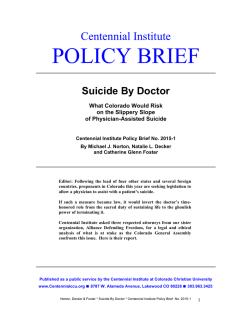
Analysis - Patients Rights Council
CALIFORNIA "END of LIFE OPTION ACT" (Analysis of Senate Bill 128) The California Bill1 is an Oregon-style doctor-prescribed suicide bill. ANALYSIS • SB 128 would give government bureaucrats and profit-driven health insurance programs the opportunity to cut costs by denying payment for more expensive treatments while approving payment for less costly assisted-suicide deaths. This has already been documented in Oregon – the state with the law upon which the California proposal is based. The Oregon Health Plan (OHP) has notified some patients that medications prescribed to extend their lives or improve their comfort level would not be covered, but that the OHP would pay for a lethal drug prescription.2 Referring to payment for assisted suicide, the Oregon Department of Human Services explains, "Individual insurers determine whether the procedure is covered under their policies, just as they do any other medical procedure."3 If the California bill is approved, will health insurance programs and government health programs do the right thing – or the cheap thing? • SB 128 would allow family members or health care providers and others to advise, suggest, encourage or exert subtle and not so subtle pressure on vulnerable individuals to request doctor-prescribed suicide. The Bill would penalize anyone for "knowingly coercing or exerting undue influence"4 on an individual to request the lethal prescription. However, those words have a very narrow legal meaning. The Bill does not prohibit someone from suggesting, advising, pressuring or encouraging a patient to request doctor-prescribed suicide. Since victims of domestic abuse, including elder abuse, are extremely vulnerable to persuasion from their abusers, it takes little imagination to understand how the Bill could put abused individuals at risk of being persuaded to request doctor-prescribed suicide. • SB 128 could lead an individual to request doctor-prescribed suicide based on fear of being a burden to others. Under the Bill, the written request is to indicate whether the individual informed or decided not to inform his or her family of the request for assisted suicide.5 But such family notification by the person is not required. If an individual fears becoming a burden and if loved ones are unaware of that concern, they are unable to reassure the person of their care and love. 1 In the last official Oregon report, fear of becoming a burden on others was given as a reason for requesting lethal drugs by more than 57 % of those who died using that state's assistedsuicide law.6 • Nothing in SB 128 requires that requests for doctor-prescribed suicide be made in person. Just as with Oregon's assisted-suicide law, the Bill requires that a person make two oral requests and a written request to the attending physician before receiving the prescription for doctor-prescribed suicide.7 Nothing in the proposal requires that any of those requests be made in person. The patient could, in fact, phone in the oral requests and mail the written request. • SB 128 permits someone who would benefit financially from the person's death to serve as a witness and to claim that the individual is mentally fit and eligible to request assisted suicide. The Bill requires that there be two witnesses to the individual's written request for doctorprescribed suicide. Only one of those witnesses shall not be a relative or someone entitled to any portion of the person's estate upon death.8 This provides little protection since it permits one witness to be a relative or someone who is entitled to the patient’s estate. The second witness could be the best friend of the first witness, and no one would know. Victims of elder abuse and domestic abuse are unlikely to share their fears with outsiders or to reveal that they are being pressured by family members to "choose" assisted suicide. • SB 128 has no protections for the person once the assisted-suicide prescription is filled. Like the Oregon law, the Bill only addresses activities taking place up until the doctor writes the lethal prescription. There are no provisions to insure that the patient is competent at the time the overdose is taken or that he or she knowingly and willingly takes the drugs. Due to this lack of protection at the time of their deaths, the Bill would put patients at enormous risk. For example, someone who would benefit from the individual's death could trick or even force the person into taking the fatal drugs, and no one would know. • SB 128 gives the illusion of choice. Yet, it would actually constrict patient choice. Under the Bill, before writing a prescription for death, a doctor must discuss “the feasible alternatives or additional treatment opportunities, including but not limited to, comfort care, hospice care, palliative care, and pain control."9 However, "discussing" all options does not mean that patient will have the ability to access those options. It only means they must be told about them. If doctor-prescribed suicide becomes just another treatment option, and a cheap option at that, the standard of care and provision of health care changes. There will be less and less 2 focus on extending life and eliminating pain, and more and more focus on the "efficient and inexpensive treatment option" of death. Patients may find that their insurance will not cover the "feasible alternatives" their doctors informed them about but, instead, will pay for doctor-prescribed suicide as has already happened in Oregon.10 • SB 128 would permit assisted-suicide prescriptions for mentally ill or depressed patients. Before receiving a prescription for death, patients do not need to have any psychological or psychiatric evaluation. A counseling referral is made "if appropriate."11 If a counseling referral is made, it may consist of only one consultation and is only for the purpose of determining whether the psychiatric or psychological disorder or depression is "causing impaired judgment."12 Even if the counselor determines that the patient has a mental disorder or disease, the prescription for suicide could still be written as long as the counselor thinks that the patient's judgment is not impaired and, therefore, he or she can make an informed decision. This provision is the same as that contained in Oregon's law where, in 2013, only two of the patients who received lethal prescriptions were referred for counseling.13 A study about Oregon's law found that it "may not adequately protect all mentally ill patients."14 • SB 128 would permit doctor-prescribed suicide for individuals who could live for many years. Under the Bill, doctors would be permitted to prescribe assisted suicide to patients who have a "terminal illness." which is defined as "an incurable and irreversible illness that has been medically confirmed and will, within reasonable medical judgment, result in death within six months."15 However, that definition does not require that the individual is expected to die within six months, even with medical treatment, nor does it require that the condition be uncontrollable. Therefore, it is possible that a person could be considered "terminal" for the purpose of qualifying for assisted suicide even if, with medical treatment, he or she could live much longer. For example, diabetes can be both incurable and irreversible but it is controllable. An insulin-dependent diabetic who stops taking insulin will, within reasonable medical judgment, die within six months. Thus, under the Bill, diabetics could be eligible for doctorprescribed suicide even though they could live virtually normal lives with insulin. There is documentation that this has occurred under Oregon's assisted-suicide law. In the latest official report from Oregon, diabetes is noted as the underlying terminal condition that made the patient eligible for a lethal prescription.16 • SB 128 would permit a third party to request assisted suicide for a patient without any oversight to determine the accuracy of the request. 3 Under the Bill, patients are considered capable of requesting assisted suicide not only by communicating the decision on their own but also by "communication through a person familiar with the individual's manner of communicating if those persons are available."17 This could include not only translating various languages but also facilitated communication18 and could lead to a patient's wishes being misunderstood, misinterpreted, or disregarded. There is no requirement that the accuracy of such communication assistance be verified. Who will know if the person translating or communicating on behalf of the patient is doing so accurately? • SB 128 would allow drugs for suicide to be mailed to a patient. Nothing in the Bill requires the patient to obtain the drugs in person. The Bill permits the lethal drugs to be delivered by "personal delivery, United Parcel Service, United States Postal Service, Federal Express, or by messenger service."19 There are no protections to prevent unintended individuals (such as children) from being given the package of drugs or taking them from the mailbox. In addition, the Bill permits the assisted-suicide drugs to be dispensed to "a person expressly designated by the patient."20 That designated person could be an abusive spouse or heir who persuaded the patient to request the prescription and who was one of the two witnesses to the patient's written request for doctor-prescribed suicide. • SB 128 could permit a representative of an assisted-suicide advocacy organization to witness a vulnerable patient's written request. In Oregon, members of the assisted-suicide advocacy group that spearheaded the state's law have acknowledged that they play a key role in the vast majority of deaths under the state's assisted-suicide law.21 The same advocacy group is pushing SB 128 and is operating in California. • SB 128 requires that the cause and manner of the patient's death be falsified. As in Oregon, the doctor who wrote the assisted-suicide prescription is not required to be present when the patient takes the drugs. According to Oregon's latest official report, prescribing physicians were present at the time of death for only 11.4% of patients who died after taking the assisted-suicide prescription.22 However, the Bill permits the attending physician to sign the death certificate and it states that the cause of death "shall be the underlying terminal illness,"23 not a drug overdose which is the true cause of death. • SB 128 could force health care facilities and providers to violate their principles and policies. Oregon's law permits a health care facility to prohibit participation in doctor-prescribed suicide on its premises as long as appropriate notice was given.24 SB 128, however, contains 4 no such protection for facilities or other entities that have policies prohibiting doctorprescribed suicide. • SB 128 could force a doctor to inform a patient about doctor-prescribed suicide at the time they inform the individual of his or her diagnosis of a terminal illness. In November 2014, California Assembly Bill 2139 passed. That bill amended the Health and Safety code. It now requires that a health care provider who gives a patient a terminal diagnosis must also give comprehensive information and counseling regarding legal end-oflife options.25 The California Department of Public Health has made it clear that, if a health care provider does not wish to comply, that provider must refer to someone who will.26 If SB 128 passes, doctor-prescribed suicide will be a "legal end-of-life option." How would a newly diagnosed patient feel when a doctor offers all options, implying that it's as good to have treatment, palliative care or a prescription for a lethal dose of drugs? • SB 128 is being considered at a time when more people in California die annually from suicide than from either motor vehicle accidents or homicide. Starting two years after its doctor-prescribed suicide law went into effect, Oregon's suicide rate skyrocketed, making it 41% higher than the nation's average.27 Already more people in California die annually from suicide than from motor vehicle accidents,28 and suicides vastly outnumber homicides29 in the state. If California adopts SB128, will the overall suicide rate in California also increase? ................................ Note: Supporters of SB 128 point to Oregon to claim that there are no problems with the law and that safeguards are meticulously followed and monitored. Yet, in closed-door sessions, they acknowledge that this is not true. For documented information about this contradiction, see "The Oregon Experience."30 1 SB 128 was introduced by Senators Wolk and Monning. KATU Television, "Letter noting assisted suicide raises questions" (interview about one such case and the response of the Oregon Health Plan). Available at: http://www.katu.com/news/26119539.html (last accessed 1/29/15). 3 Oregon Dept. of Human Services, "FAQs about the Death with Dignity Act." Available at: http://public.health.oregon.gov/ProviderPartnerResources/EvaluationResearch/DeathwithDignityAct/Pages/faqs. aspx (last accessed 12/30/14). 4 Section 443.14 (b). 5 Section 443.9 (a). 6 Official report for 2013 deaths under Oregon's Death with Dignity Act, pg. 6. Available at: http://public.health.oregon.gov/ProviderPartnerResources/EvaluationResearch/DeathwithDignityAct/Documents/ year16.pdf (last accessed 12/30/14). 7 Section 443.3 (a). 8 Section 443.9 (a). 9 Section 443.5 (a) (2) (E). 2 5 10 KATU Television, "Letter noting assisted suicide raises questions" (interview about one such case and the response of the Oregon Health Plan). Available at: http://www.katu.com/news/26119539.html (last accessed 1/29/15). 11 Section 443.5 (a) (4). 12 Section 443.1 (f) 13 Official report for 2013 deaths under Oregon's Death with Dignity Act, p. 6. Available at: http://public.health.oregon.gov/ProviderPartnerResources/EvaluationResearch/DeathwithDignityAct/Documents/ year16.pdf (last accessed 12/30/14). 14 Linda Ganzini, Elizabeth R. Goy, Steven K. Dobscha, "Prevalence of depression and anxiety in patients requesting physicians' aid in dying: cross sectional survey," British Medical Journal, Oct. 25, 2008, pp. 973-978. 15 Section 443.1 (o). 16 Official report for 2013 deaths under Oregon's Death with Dignity Act, p. 7, fn. 6. Available at: http://public.health.oregon.gov/ProviderPartnerResources/EvaluationResearch/DeathwithDignityAct/Documents/ year16.pdf. (last accessed 12/30/14). 17 Section 443.1 (d). 18 Facilitated communication is that in which a person, called a "facilitator," supports the hand or arm of an individual who is impaired, using a device such as a keyboard to help the individual communicate. 19 Section 443.5 (c). 20 Section 443.5 (c). 21 Officers of Compassion in Dying/Compassion & Choices of Oregon were the chief proponents of Oregon’s assisted-suicide law. They have proclaimed themselves stewards of the law. According to one spokesperson for the organization, in 2009, it was involved in 97% of deaths under the law. For documentation see: "The Proportion of Oregon Assisted Suicides by Compassion & Choices Organization." Available at: http://www.patientsrightscouncil.org/site/oregon-assisted-suicide-deaths (last accessed 12/30/14). 22 Oregon's Death with Dignity Act – 2013," p. 3 and 6. Available at: http://public.health.oregon.gov/ProviderPartnerResources/EvaluationResearch/DeathwithDignityAct/Documents/yea r16.pdf (last accessed 1/30/15). 23 Section 443.7 (b). 24 ORS 127.885 S. 4.01 (5). Available at: http://public.health.oregon.gov/ProviderPartnerResources/EvaluationResearch/DeathwithDignityAct/Pages/ors.aspx (last accessed 1/30/15). 25 Cal. Health & Safety Code Sec. 442.5–442.7. 26 Letter from California Department of Public Health to All Health Care Facilities, November 12, 2014. Available at: http://coalitionccc.org/wp-content/uploads/2014/12/ab2139_end_of_life_CDOHmandate.pdf?utm_source=Coalition+for+Compassionate+Care+of+California&utm_campaign=26f942e282January_2015_public_policy1_16_2015&utm_medium=email&utm_term=0_fe8bdd104b-26f942e282-165203937 (last accessed 1/30/15). 27 Oregon's suicide rate increased by 49.3 percent, making it 41 percent higher than the national rate. Available at: http://www.oregonlive.com/health/index.ssf/2013/05/report_oregons_suicide_rate_hi.html (last accessed 01/31/15). 28 In 2010, there were 3,913 suicide deaths and 2,922 deaths from motor vehicle accidents in California. National Vital Statistics Reports Volume 61, Number 4, "Deaths: Final Data for 2010", May 8, 2013, p. 88. Available at: http://www.cdc.gov/nchs/data/nvsr/nvsr61/nvsr61_04.pdf (last accessed 01/29/2015). 29 In 2010, there were 3,913 suicide deaths and 1,954 homicide deaths in California. National Vital Statistics Reports Volume 61, Number 4, "Deaths: Final Data for 2010", May 8, 2013, pp. 88, 89. Available at: http://www.cdc.gov/nchs/data/nvsr/nvsr61/nvsr61_04.pdf (last accessed 01/29/2015). 30 "The Oregon Experience." Available at: http://www.patientsrightscouncil.org/site/the-oregon-experience (last accessed 1/30/15). Patients Rights Council P.O. Box 760 Steubenville, OH 43952 740-282-3810 or 800-958-5678 http://www.patientsrightscouncil.org Copyright © 2015 6
© Copyright 2026




![Download [ PDF ] - journal of evidence based medicine and](http://s2.esdocs.com/store/data/000505409_1-2bc4ae284ea460180bc089744a6eaaca-250x500.png)



